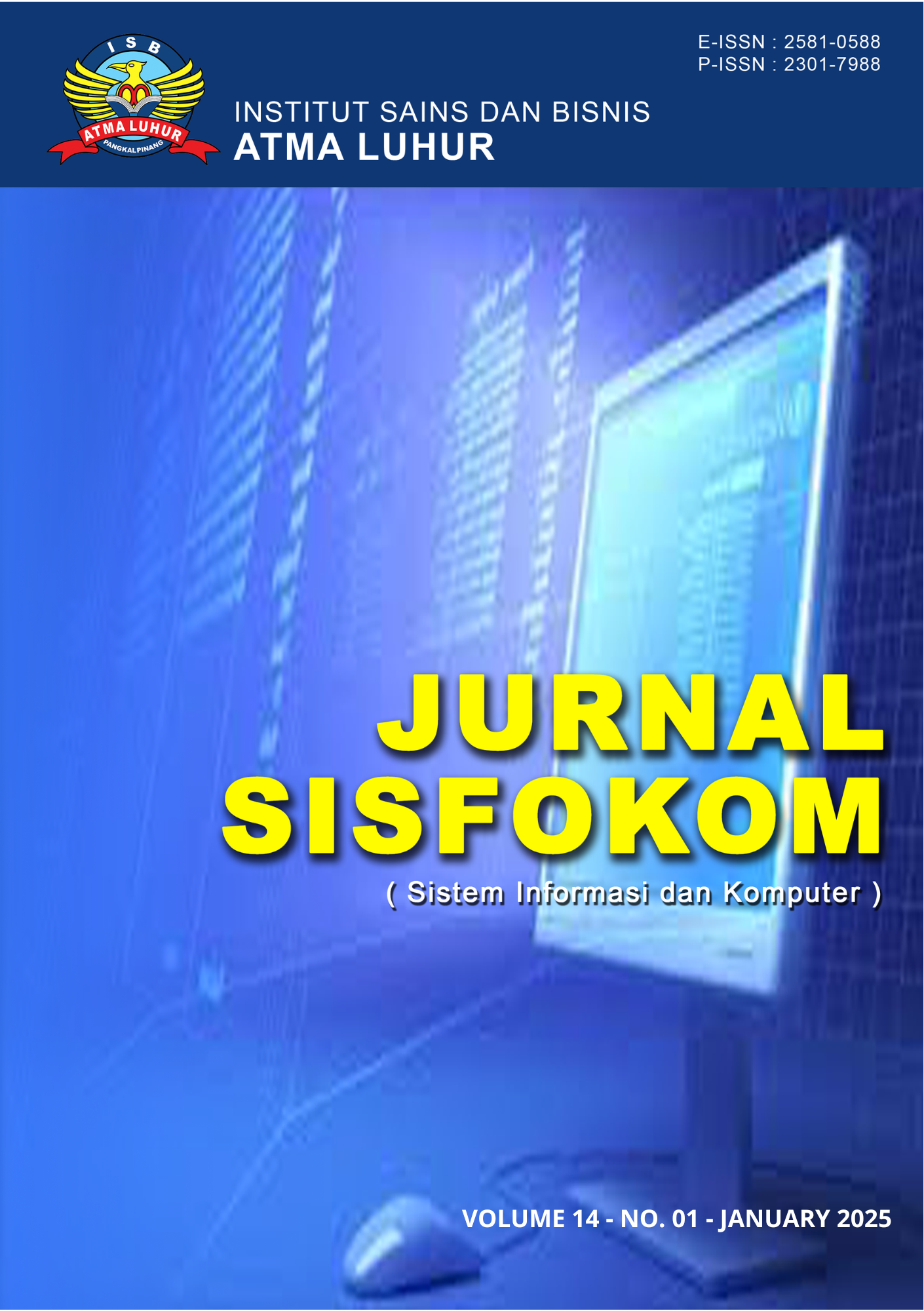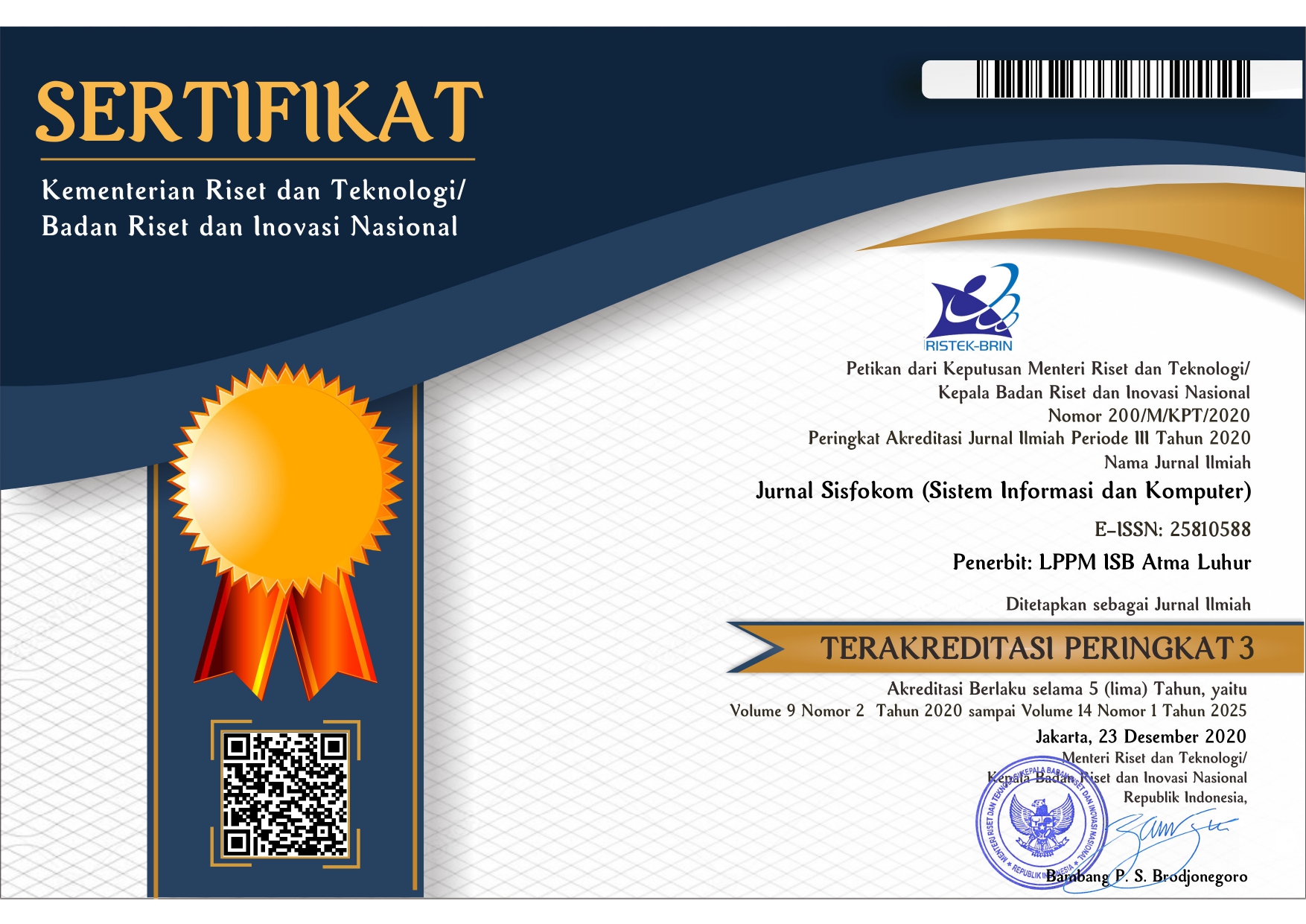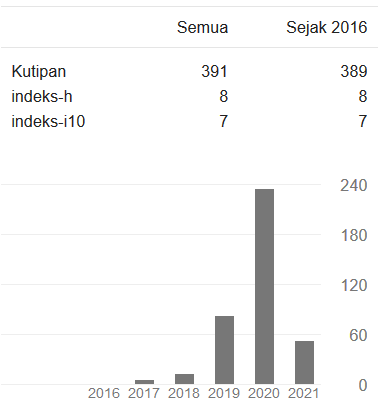Post-Pandemic Usage of Collaboration Tools: Influencing Factors
DOI:
https://doi.org/10.32736/sisfokom.v14i1.2295Keywords:
Social Distancing, Collaboration Tools, ECM, TAM, PLS-SEMAbstract
The distance existed due to the COVID-19 pandemic drove people to utilize collaboration tools to continue communication, coordination, and collaboration. The increasing use of collaboration tools during WFH impact on our way of working. The collaboration tools also offer efficiencies, allow workers to break silos, and increase the quality of communication at the company-wide level. As we recover from the pandemic, the government revoked the social distancing policy and it is assumed to influence the continued use of collaboration tools as people fully carry out their activities face-to-face again. This study aims to understand the continuance usage of collaboration tools after no more social distancing. This study also seeks to identify the factors influencing the ongoing use of collaboration tools by integrating the Technology Acceptance Model (TAM) and Expectation Confirmatory Model (ECM). The method of data analysis employed was the partial least squares structural equation model (PLS-SEM). The findings indicated that most of 437 respondents kept using collaboration tools after no more social distancing. However, there was a decrease in the frequency of use. Our study findings have also proved that Actual Continued Usage is influenced by Continuance Intention by 43%. Factor that influences continuance intention the most is the attitude toward using collaboration tools, which is influenced by users’ perceived usefulness of the collaboration tools. The results of this study also support the integration of TAM and ECM to examine user intentions and behavior regarding the continuance use of a technology.References
A. Rifai, M. S. Maarif, and A. Sukmawati, “Key to Succesful Implementation of Flexible Working Space as A New Normality in Public Organizations,” Bus. Rev. Case Stud., vol. 2, no. 1, pp. 23–35, Apr. 2021, doi: 10.17358/brcs.2.1.24.
S. Q. Yang and L. Li, Emerging Technologies for Librarians. A Practical Approach in Innovation. Massachusetts: Elsevier Ltd., 2016. doi: 10.1016/b978-1-84334-788-0.00013-6.
V. Jackson, A. Van der Hoek, R. Prikladnicki, and C. Ebert, “Collaboration Tools for Developers,” IEEE Softw., vol. 39, no. 2, pp. 7–15, Mar. 2022, doi: 10.1109/MS.2021.3132137.
M. Schmidtner, C. Doering, and H. Timinger, “Agile Working During COVID-19 Pandemic,” IEEE Eng. Manag. Rev., vol. 49, no. 2, pp. 18– 32, Jun. 2021, doi: 10.1109/EMR.2021.3069940.
M. L. Rethlefsen, D. L. Rothman, and D. S. Mojon, “Collaboration Tools,” in Internet Cool Tools for Physicians, no. August, Berlin, Heidelberg: Springer Berlin Heidelberg, 2009, pp. 119–128. doi: 10.1007/978-3-540-76382-6_17.
M. Miljanic and N. Zaric, “Review of collaborative software applications and integration with standard collaboration tools,” in 2020 International Conference on Information Technology (IT), Feb. 2020, no. November 2019, pp. 1–4. doi: 10.1109/IT48810.2020.9070420.
A. Thayer, M. J. Bietz, K. Derthick, and C. P. Lee, “I love you, let’s share calendars,” in Proceedings of the ACM 2012 conference on Computer Supported Cooperative Work, Feb. 2012, pp. 749–758. doi: 10.1145/2145204.2145317.
K. Tanner, “Visual Design Tools in Support of Novice Creativity,” Standford University, 2019.
P. Farmoudehyamcheh, “A Systems Approach to Graphic Design Practice Recommended Citation,” Georgia Southern University, 2019. [Online]. Available:
https://digitalcommons.georgiasouthern.edu/etd/2021
V. Jackson, A. van der Hoek, and R. Prikladnicki, “Collaboration tool choices and use in remote software teams,” in Proceedings of the 15th International Conference on Cooperative and Human Aspects of Software Engineering, May 2022, pp. 76–80. doi: 10.1145/3528579.3529171.
Asosiasi Penyelenggara Jasa Internet Indonesia, “Indonesian Internet Profile 2022,” Jakarta, 2022. [Online]. Available: apji.or.id
Y.-M. Huang, “The factors that predispose students to continuously use cloud services: Social and technological perspectives,” Comput. Educ., vol. 97, pp. 86–96, Jun. 2016, doi: 10.1016/j.compedu.2016.02.016.
A. I. Safira, P. W. Handayani, and A. A. Pinem, “The Meaning of User Satisfaction and Continuance Intentions with Video Conference Applications,” in 2021 International Conference on Informatics, Multimedia, Cyber and Information System (ICIMCIS, Oct. 2021, pp. 250–256. doi: 10.1109/ICIMCIS53775.2021.9699164.
S. A. Nikou, “Web-based videoconferencing for teaching online: Continuance intention to use in the post-COVID-19 period,” Interact. Des. Archit., vol. 47, no. 47, pp. 123–143, Feb. 2021, doi: 10.55612/s-
5002-047-006.
H.-L. Yang and S.-L. Lin, “User continuance intention to use cloud storage service,” Comput. Human Behav., vol. 52, pp. 219–232, Nov. 2015, doi: 10.1016/j.chb.2015.05.057.
X. Tan and Y. Kim, “User acceptance of SaaS-based collaboration tools: a case of Google Docs,” J. Enterp. Inf. Manag., vol. 28, no. 3, pp. 423– 442, Apr. 2015, doi: 10.1108/JEIM-04-2014-0039.
F. Gunadi, “Analisa Pengaruh Trust Dan Risk Berbasis Technology Acceptance Models (TAM) (Studi Kasus : Pengguna Google Drive),” MULTINETICS, vol. 6, no. 1, pp. 67–77, Aug. 2020, doi:
10.32722/multinetics.v6i1.2819.
N. Marangunić and A. Granić, “Technology acceptance model: a literature review from 1986 to 2013,” Univers. Access Inf. Soc., vol. 14, no. 1, pp. 81–95, Mar. 2015, doi: 10.1007/s10209-014-0348-1.
C. Liao, P. Palvia, and J.-L. Chen, “Information technology adoption behavior life cycle: Toward a Technology Continuance Theory (TCT),” Int. J. Inf. Manage., vol. 29, no. 4, pp. 309–320, Aug. 2009, doi: 10.1016/j.ijinfomgt.2009.03.004.
S. A. Nikou, “Web-based videoconferencing in online teaching during the COVID-19 pandemic: University students’ perspectives,” in 2021 International Conference on Advanced Learning Technologies (ICALT), Jul. 2021, pp. 431–435. doi: 10.1109/ICALT52272.2021.00137.
M.-C. Lee, “Explaining and predicting users’ continuance intention toward e-learning: An extension of the expectation–confirmation model,” Comput. Educ., vol. 54, no. 2, pp. 506–516, Feb. 2010, doi: 10.1016/j.compedu.2009.09.002.
G. Malik and A. S. Rao, “Extended expectation-confirmation model to predict continued usage of ODR/ride hailing apps: role of perceived value and self-efficacy,” Inf. Technol. Tour., vol. 21, no. 4, pp. 461–482, Dec. 2019, doi: 10.1007/s40558-019-00152-3.
Y.-M. Cheng, “Drivers of physicians’ satisfaction and continuance intention toward the cloud-based hospital information system,” Kybernetes, vol. 50, no. 2, pp. 413–442, Mar. 2021, doi: 10.1108/K-09-
2019-0628.
F. D. . Davis, R. P. . Bagozzi, and P. R. . Warshaw, “User Acceptance of Computer Technology: A Comparison of Two Theoretical Models,” Manage. Sci., vol. 35, no. 8, pp. 982–1003, 1989.
F. D. Davis, “Perceived Usefulness, Perceived Ease of Use, and User Acceptance of Information Technology,” MIS Q., vol. 13, no. 3, pp. 319– 340, 1989, [Online]. Available: http://www.biodiversitylibrary.org/bibliography/33621
A. Bhattacherjee, “Understanding Information Systems Continuance: An Expectation-Confirmation Model,” MIS Q., vol. 25, no. 3, pp. 351–370, 2001.
A. P. Oghuma, C. F. Libaque-Saenz, S. F. Wong, and Y. Chang, “An expectation-confirmation model of continuance intention to use mobile instant messaging,” Telemat. Informatics, vol. 33, no. 1, pp. 34–47, Feb. 2016, doi: 10.1016/j.tele.2015.05.006.
N. Fathema, D. Shannon, and M. Ross, “Expanding The Technology Acceptance Model (TAM) to Examine Faculty Use of Learning Management Systems (LMSs) In Higher Education Institutions,” J. Online Learn. Teach. , vol. 11, no. 2, pp. 210–233, 2015.
M. Darwin et al., Metode Penelitian. Pendekatan Kuantitatif. Bandung: CV Media Sains Indonesia, 2020.
J. F. Hair, G. T. M. Hult, C. M. Ringle, and M. Sarstedt, A Primer on Partial Least Squares Structural Equation Modeling (PLS-SEM) Third Edition. Los Angeles: SAGE Publications, Inc., 2022.
R. R. Marliana, “Partial Least Square-Structural Equation Modeling pada Hubungan Antara Tingkat Kepuasan Mahasiswa dan Kualitas Google Classroom Berdasarkan Metode Webqual 4.0,” J. Mat. Stat. dan Komputasi, vol. 16, no. 2, p. 174, Dec. 2019, doi: 10.20956/jmsk.v16i2.7851.
J. F. Hair, J. J. Risher, M. Sarstedt, and C. M. Ringle, “When to use and how to report the results of PLS-SEM,” Eur. Bus. Rev., vol. 31, no. 1,
pp. 2–24, Jan. 2019, doi: 10.1108/EBR-11-2018-0203.
C. Fornell and D. F. Larcker, “Evaluating Structural Equation Models with Unobservable Variables and Measurement Error,” J. Mark. Res., vol. 18, no. 1, pp. 39–50, 1981.
Downloads
Published
Issue
Section
License
Copyright (c) 2025 Jurnal Sisfokom (Sistem Informasi dan Komputer)

This work is licensed under a Creative Commons Attribution 4.0 International License.
The copyright of the article that accepted for publication shall be assigned to Jurnal Sisfokom (Sistem Informasi dan Komputer) and LPPM ISB Atma Luhur as the publisher of the journal. Copyright includes the right to reproduce and deliver the article in all form and media, including reprints, photographs, microfilms, and any other similar reproductions, as well as translations.
Jurnal Sisfokom (Sistem Informasi dan Komputer), LPPM ISB Atma Luhur, and the Editors make every effort to ensure that no wrong or misleading data, opinions or statements be published in the journal. In any way, the contents of the articles and advertisements published in Jurnal Sisfokom (Sistem Informasi dan Komputer) are the sole and exclusive responsibility of their respective authors.
Jurnal Sisfokom (Sistem Informasi dan Komputer) has full publishing rights to the published articles. Authors are allowed to distribute articles that have been published by sharing the link or DOI of the article. Authors are allowed to use their articles for legal purposes deemed necessary without the written permission of the journal with the initial publication notification from the Jurnal Sisfokom (Sistem Informasi dan Komputer).
The Copyright Transfer Form can be downloaded [Copyright Transfer Form Jurnal Sisfokom (Sistem Informasi dan Komputer).
This agreement is to be signed by at least one of the authors who have obtained the assent of the co-author(s). After submission of this agreement signed by the corresponding author, changes of authorship or in the order of the authors listed will not be accepted. The copyright form should be signed originally, and send it to the Editorial in the form of scanned document to sisfokom@atmaluhur.ac.id.









